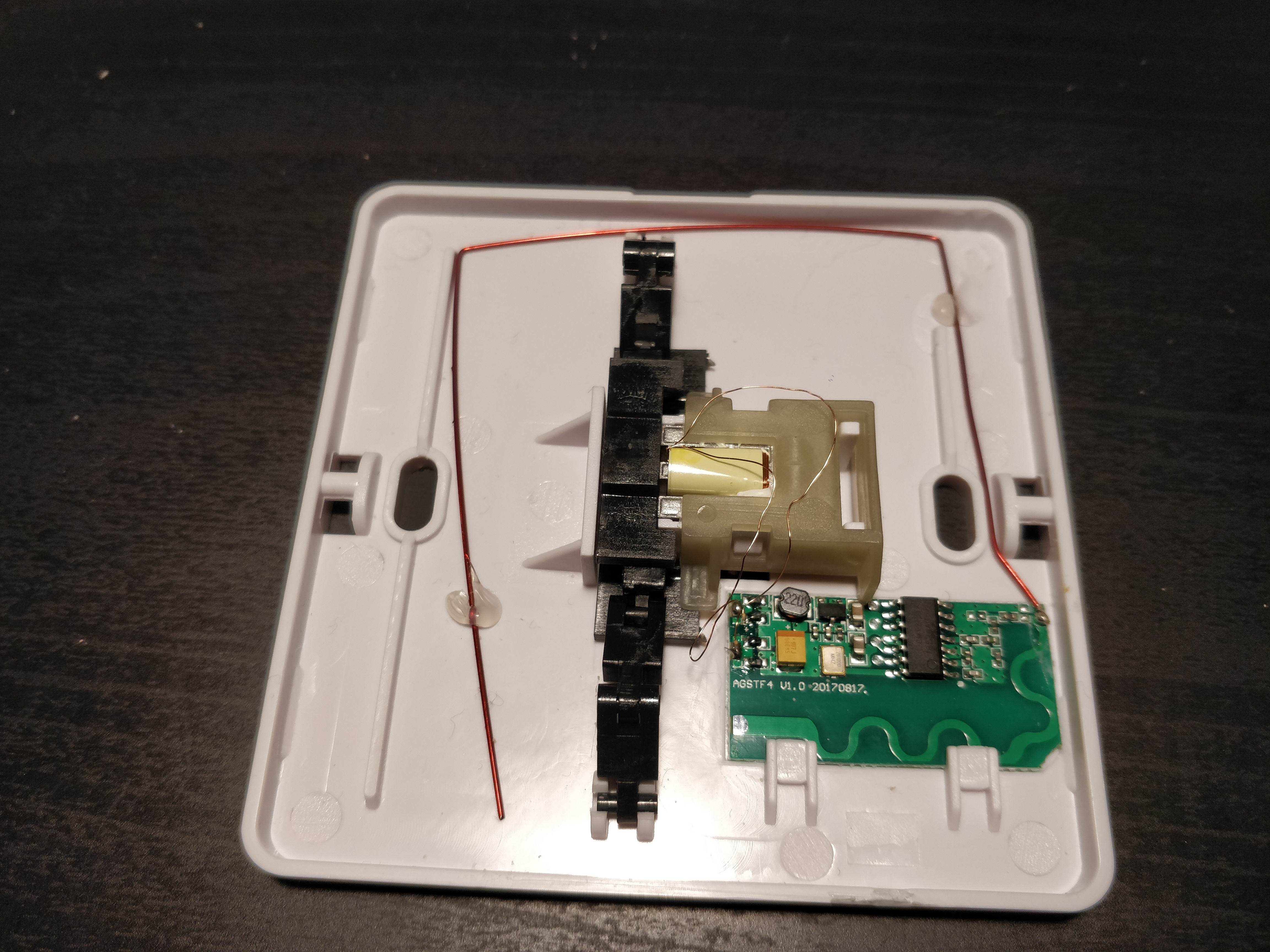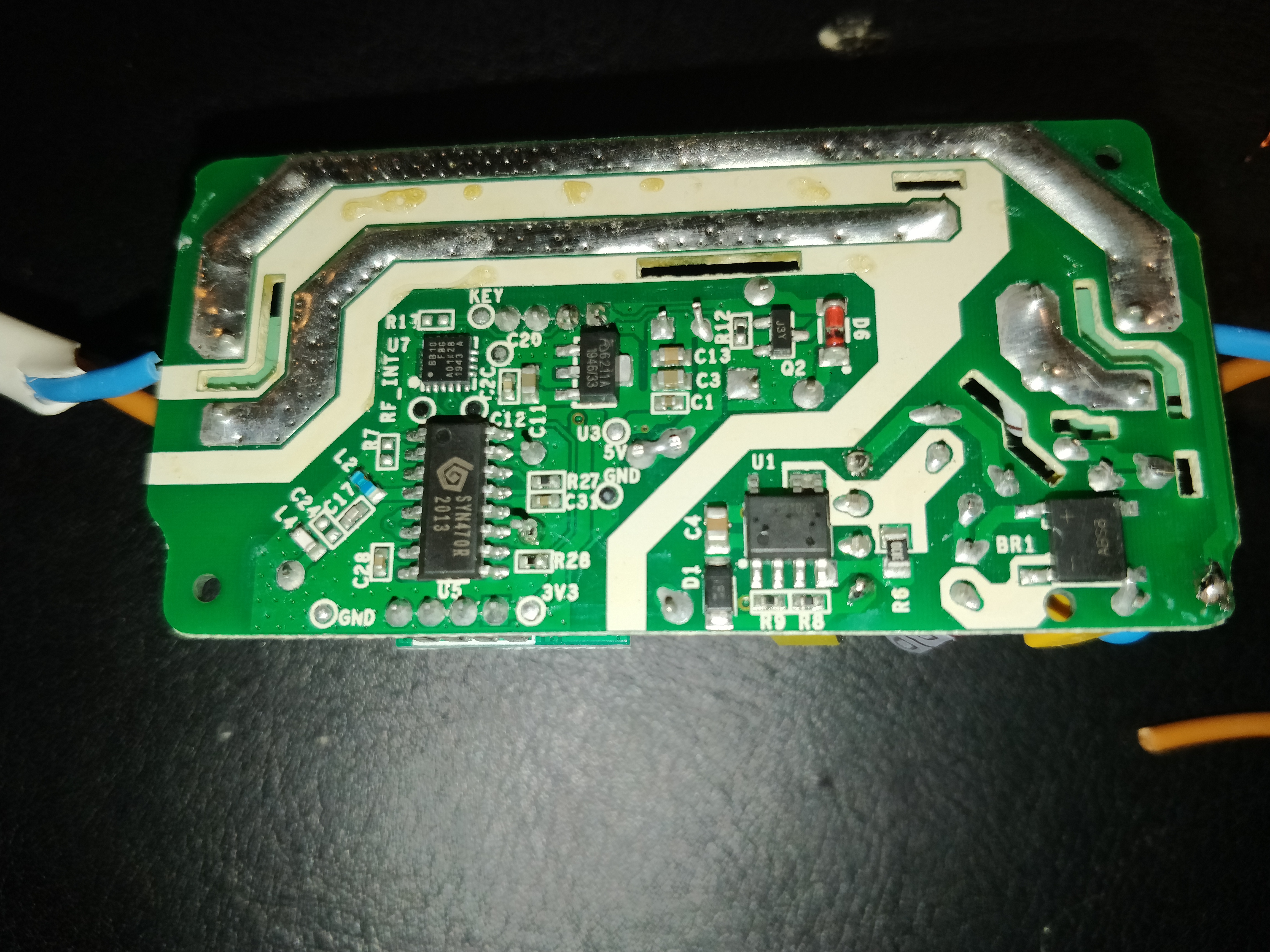
So, I wanted to make my home smarter: rig up the lights so that I could control them remotely. I wanted the system to have some nice properties:
Sounds simple enough, right?
After a brief look around the internet, I had a rough idea of the components that I need:
I went with the AS-6M light switch from the link above and a Sonoff RFR3 relay, bought from a local supplier.
The switch feels alright, I guess. Action is definitive and doesn’t take too much force. It can be disassembled relatively easily by first unclipping the frame and then the button. It looks like this inside: 
The relay made a great initial impression. The box is made of nice plastic, and the cover can be unclipped without a screwdriver. Wire connectors are easy to use, you only need a philips screwdriver to connect it up.
However, the controls of the relay are unimaginably horrible. According to the manual, in order to reset the device and switch it to “pairing” mode, one needs to hold the button down for 5 seconds; and to pair a new RF433 remote, one needs to hold the button
until the red remote-controlled LED indicator flashes once
Here’s the catch: the red light flashes after you hold the button for about 5 seconds, and when you let go of the button one of the three things happen, seemingly chosen at random:
After reading the manual twice, I still have no idea what the blinking light is supposed to represent. I’m guessing that one of the patterns means it has been “reset”, and the other one means it’s looking for a remote? Hard to say.
Anyways, I didn’t want to use the proprietary app that Sonoff suggests, so I tried to put the relay in “DIY mode”. How do I do it? You guessed it:
Long press the button for 5 seconds to enter Compatible Pairing Mode (AP)
Ummmm… So, now there are three actions associated with holding the button down for 5 seconds?
After some fumbling around by pressing the button down for 5 seconds a number of times, I managed to get it into the AP mode. I think what I did was reset the relay by holding the button down until the blue LED lights, check that the blue LED does two short flashes and a long one, then press the button down for 5 seconds again until the blue LED starts quickly and regularly flashing. The ITEAD-<...> network showed up on my laptop. The rest of it went according to the DIY manual: visit http://10.10.7.1, log in to my wifi network (I’ve set up a separate network with a separate firewall zone, so that those “smart” devices can’t access the internet), wait for it to connect.
Now, how does one query and control the relay? There’s a helpful repository with the documentation, but I’ll save you the time and give a quick rundown.
The device advertises itself via mDNS. On Linux, mDNS discovery is done with Avahi. Make sure you have it installed and run avahi-daemon as root. To get the information from all Sonoff devices present on your network, run avahi-browse -ltpr _ewelink._tcp (-l to ignore local services, -t to terminate after dumping all the devices, -p to produce machine-readable output, -r to resolve the records).
You can then parse the output (it’s separated with ; which are escaped if found in TXT records). We’re most interested in fields 8, 9 and 10 – IP address, port, and the device information. In the 10th field, you can see a data1 record, which contains information about device’s state (in the case of my switch, the only interesting bits are switch and startup). Also note the deviceid record, which will be useful later.
My device has IP 192.168.8.120, port 8081, and deviceid 1000ed8684. Substitute your own values in the rest of the article.
There’s also a second way to query the device, and it’s really strange.
The full REST-ish API is described in the documentation repo mentioned above, but in short:
$ # Query all the device information (data1 from above)
$ curl -X POST -d '{"deviceid":"1000ed8684","data":{}}' 192.168.8.120:8081/zeroconf/info
{"seq":41,"error":0,"data":{"switch":"on","startup":"off","pulse":"off","pulseWidth":500,"ssid":"Keenetic2","otaUnlock":false,"fwVersion":"3.6.0","deviceid":"1000ed8684","bssid":"ec:43:f6:d7:dd:a2","signalStrength":-51}}
$ # Turn the switch off
$ curl -X POST -d '{"deviceid":"1000ed8684","data":{"switch":"off"}}' 192.168.8.120:8081/zeroconf/switch
{"seq":41,"error":0}
$ # Turn the switch on again
$ curl -X POST -d '{"deviceid":"1000ed8684","data":{"switch":"on"}}' 192.168.8.120:8081/zeroconf/switch
{"seq":42,"error":0}
$ # You get the idea...Yes, this is how the API is supposed to be used. It always uses POST, and has separate endpoints that nevertheless use a common JSON structure.
What is absolutely mind-blowing to me is that the device seems pretty well-engineered other than its interfaces to the outside world. The separation between tracks is good and there are anti-tracking slots:

the box is well-made, and the software seems to be working reliably.
But let’s not forget that the interface is excruciatingly awful. I don’t understand how an engineer who made this thought “yep, this is what we’re going to ship”. And while adding more buttons would increase the cost and the complexity of the device (components are quite crammed on the circuitboard as it is), making the REST API better would take literally on the order of minutes, with no additional cost.
Now that I’ve set up the WiFi part of the relay, it’s time to pair it with the remote, right?
Well, after a lot of 5 second button presses and frustration, I can tell you that the two are probably incompatible. I don’t have any other 433MHz receivers or transmitters handy (but one transmitter is on the way), so I can’t debug this further. Poking a multimeter in the kinetic switch shows about 600mV between the power contacts right after the click, so I’m assuming it’s working fine. The relay also appears to be working, so the reasonable assumption to make is that the two just don’t work together.
To be continued after the battery-powered transmitter arrives.
Eventually, I would like to control all of my lighting and other appliances via home-assistant. It has a nice web interface, a mobile app, and API with a CLI command for scripting. I might write a simple GTK app for it in the future.
For now, here’s how to set up home-assistant with sonoff integration on NixOS: https://github.com/balsoft/nixos-config/commit/e54fd18fbbd01f41e1b96aee912add157c13930e .